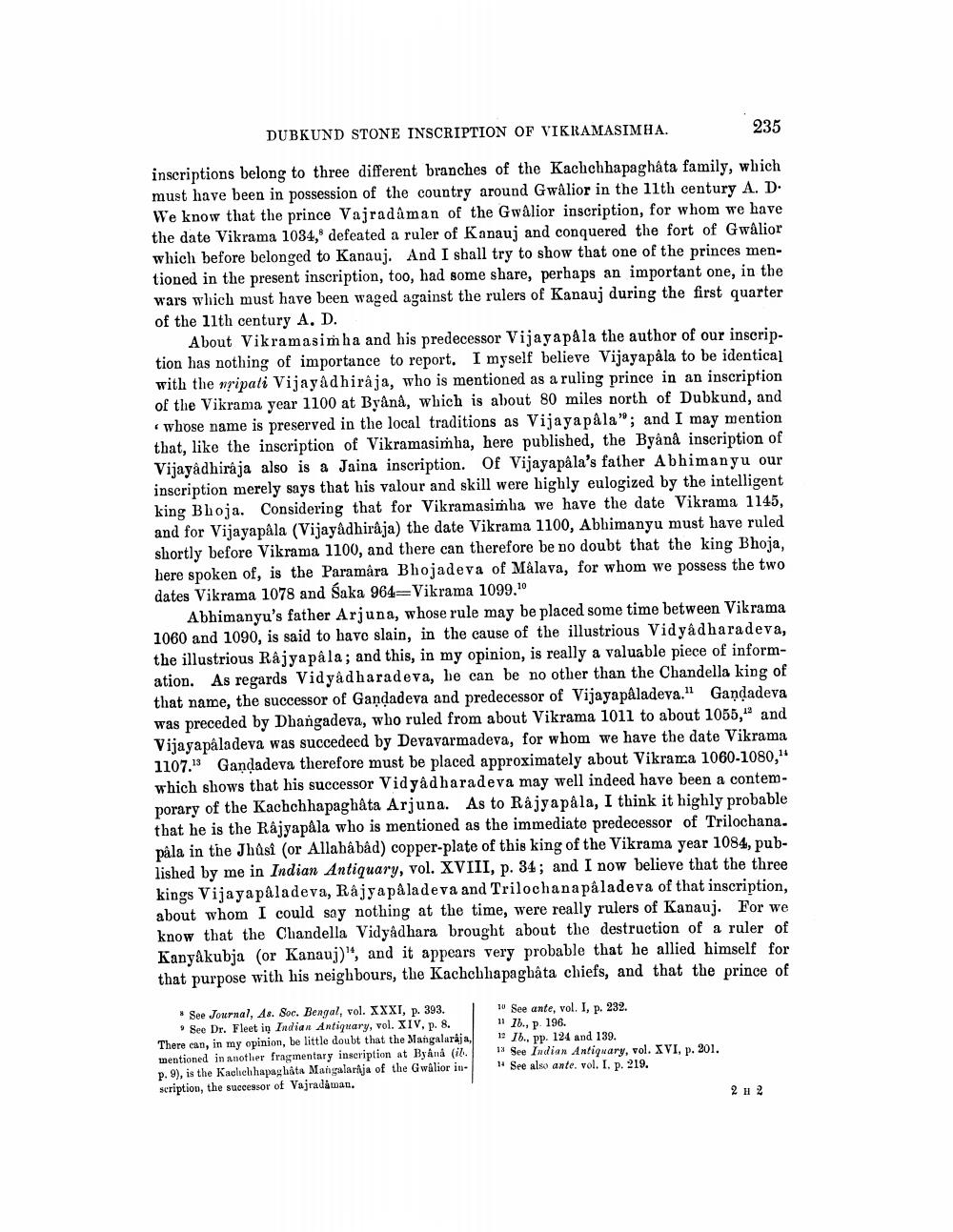________________
DUBKUND STONE INSCRIPTION OF VIKRAMASIMHA.
235
inscriptions belong to three different branches of the Kachchhapaghata family, which must have been in possession of the country around Gwalior in the 11th century A. D: We know that the prince Vajradâman of the Gwalior inscription, for whom we have the date Vikrama 1034, defeated a ruler of Kanauj and conquered the fort of Gwalior which before belonged to Kanauj. And I shall try to show that one of the princes mentioned in the present inscription, too, had some share, perhaps an important one, in the wars which must have been waged against the rulers of Kanauj during the first quarter of the 11th century A. D.
About Vikramasimha and his predecessor Vijayapala the author of our inscription has nothing of importance to report. I myself believe Vijayapala to be identical with the uripali Vijayadhiraja, who is mentioned as a ruling prince in an inscription of the Vikrama year 1100 at Byânâ, which is about 80 miles north of Dubkund, and
whose name is preserved in the local traditions as Vijaya pala"; and I may mention that, like the inscription of Vikramasimha, here published, the Byånå inscription of Vijayâdhiraja also is a Jaina inscription. Of Vijayapâla's father Abhimanyu our inscription merely says that his valour and skill were highly eulogized by the intelligent king Bhoja. Considering that for Vikramasiṁha we have the date Vikrama 1145, and for Vijayapála (Vijayâdhirâja) the date Vikrama 1100, Abhimanyu must have ruled shortly before Vikrama 1100, and there can therefore be no doubt that the king Bhoja, here spoken of, is the Paramara Bhojadeva of Málava, for whom we possess the two dates Vikrama 1078 and Saka 964=Vikrama 1099.10
Abhimanyu's father Arjuna, whose rule may be placed some time between Vikrama 1060 and 1090, is said to have slain, in the cause of the illustrious Vidyadharadeva, the illustrious Rajyapâla; and this, in my opinion, is really a valuable piece of information. As regards Vidyadharadeva, he can be no other than the Chandella king of that name, the successor of Gandadeva and predecessor of Vijayapaladeva. Gandadeva was preceded by Dhangadeva, who ruled from about Vikrama 1011 to about 1055," and Vijayapaladeva was succedeed by Devavarmadeva, for whom we have the date Vikrama 1107.13 Gandadeva therefore must be placed approximately about Vikrana 1060-1080, which shows that his successor Vidyadharadeva may well indeed have been a contemporary of the Kachchhapaghata Arjuna. As to Rajyapala, I think it highly probable that he is the Rajyapala who is mentioned as the immediate predecessor of Trilochana. pala in the Jhúsi (or Allahâbâd) copper-plate of this king of the Vikrama year 1084, published by me in Indian Antiquary, vol. XVIII, p. 34; and I now believe that the three kings Vijayapaladeva, Rajyapaladeva and Trilochana paladeva of that inscription, about whom I could say nothing at the time, were really rulers of Kanauj. For we know that the Chandella Vidyadhara brought about the destruction of a ruler of Kanyakubja (or Kanauj)", and it appears very probable that he allied himself for that purpose with his neighbours, the Kachchhapagbåta chiefs, and that the prince of
* See Journal, As. Soc. Bengal, vol. XXXI, p. 393.
See Dr. Fleet in Indian Antiquary, vol. XIV, p. 8. There can, in my opinion, be little doubt that the Mangalaraja, mentioned in another fragmentary inscription at ByAna (ili p. 9), is the Kacheh hapag hata Mangalaraja of the Gwalior inseription, the successor of Vajradaman.
10 See ante, vol. I, p. 232. 11 16., p. 196. 12 16., pp. 124 and 139. 1 See Indian Antiquary, vol. XVI, p. 201. " See also ante. vol. I. p. 219.
2 1 2




